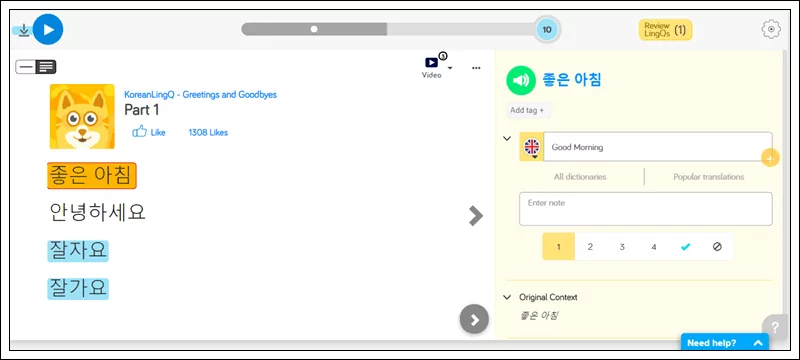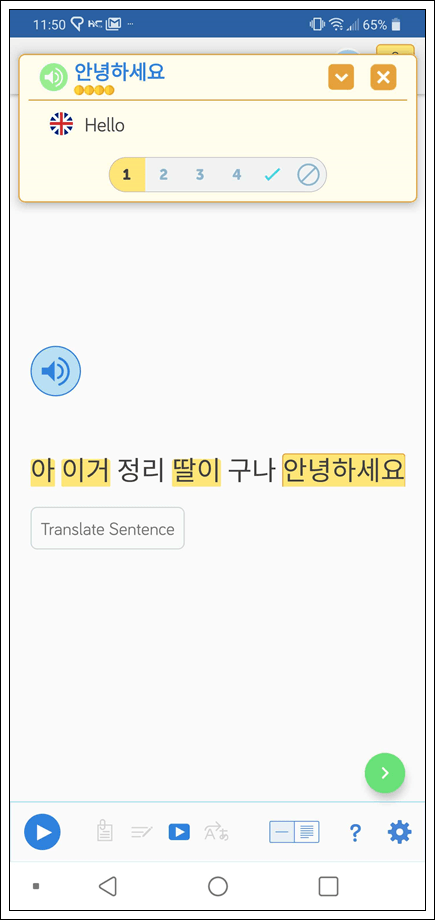Korean Greetings for Absolute Beginners
Whether you’re studying Korean or any other language, greetings are probably the first things you will come across in your studies.
Greetings are usually short and easy to remember and can make a good impression when you bump into a native speaker.
Today, I’ll go over a few common Korean greetings found in Korean songs and TV shows which you can use in almost any situation. Let’s go!
안녕하세요
(0:17)
“네가 정민이 딸이구나!”
“안녕하세요”
The video clip is from the popular Korean TV Show High Kick!, where Yoomi is meets her mother’s friend, Haemi, for the first time.
안녕하세요 means ‘Hello’ and is the most common greeting in Korean. It’s often used in a formal situation, such as meeting a boss or someone new. If you’re with friends, you can simply say 안녕 which is more informal.
좋은 아침
(1:12)
“좋은 아침이야”
The lyrics from the song ‘Good Morning’, by Verbal Jint, are about a man who wishes his girlfriend good morning.
좋은 아침 is a literal translation of ‘good morning’ in Korean. You can say 좋은 아침입니다 or 좋은 아침이에요 for formal situations or simply 좋은 아침 for informal situations.
여보세요
(4:00)
“여보세요”
In this clip from the TV show Nonstop, the band members are impressed by Hakyoung’s guitar playing. That is, until they realize it was actually his phone’s ringtone going off.
여보세요 is a Korean greeting used when you pick up a phone call. It is used in informal and formal situations.
반가워요
(1:30)
“반가워요, 써니에요”
반가워요 means ‘nice to meet you’ in Korean. Variations include 반갑습니다 or 반가워. You can sa your name afterwards to complete the greeting 🙂 Similar as to what Sunny is doing in the above video clip from The Guardian.
잘 부탁드립니다
(3:10)
“잘 부탁드립니다 “
The song 잘 부탁드립니다 , by Ex, is about an unemployed college-grad who’s been rejected by a hiring manager. The greeting ‘잘 부탁드립니다’ is mentioned often. Ex sings it in a way as if she was hired for the job and began introducing herself to her new team. In reality, she is singing to a stranger after having a drink to ease the pain.
You would say 잘 부탁드립니다 when you meet someone for the first time. Usually it is said in a business related setting. This Korean greeting literally means ‘please take a good care (of the project)’.
어떻게 지냈니?
(0:49)
“그동안 어떻게 지냈니”
iKon’s Long Time No See is a song of a broken couple who haven’t seen each other in a while and they are getting back together again.
어떻게 지냈니 means ‘how have you been?’. The formal version of this Korean greeting is 어떻게 지내셨어요. 어떻게 지냈니/지냈어 can be used in informal situations.
Learning Korean greetings on LingQ
If you want to learn more Korean greetings and learn them in context, check out LingQ.
LingQ comes pre-loaded with 100s of lessons that you can read, listen to, look up new vocabulary, review, and much more 🙂

Not only do you have a variety of lessons to choose from but you can also import content you enjoy into LingQ, turning them into interactive lessons. For example, below is a screenshot an imported clip from High Kick on LingQ’s mobile app.

LingQ makes reading the dialogue so much easier. Also, you can listen to the audio and look up new vocabulary. Best of all, you can store all my favourite content into LingQ and study anytime, anywhere.
Check out LingQ today to discover how to learn Korean from content you love!
Enjoyed this post? Check out polyglot and LingQ cofounder Steve Kaufmann’s blog post to learn about the similarities and differences between learning Korean vs Japanese vs Chinese!
***
Julie Yoon has been teaching Korean and English in formal and informal settings for ten years. She has been learning French as a third language.


